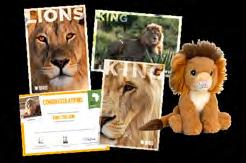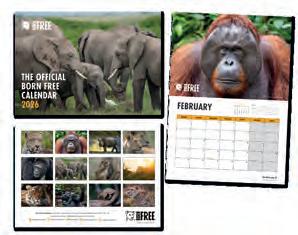
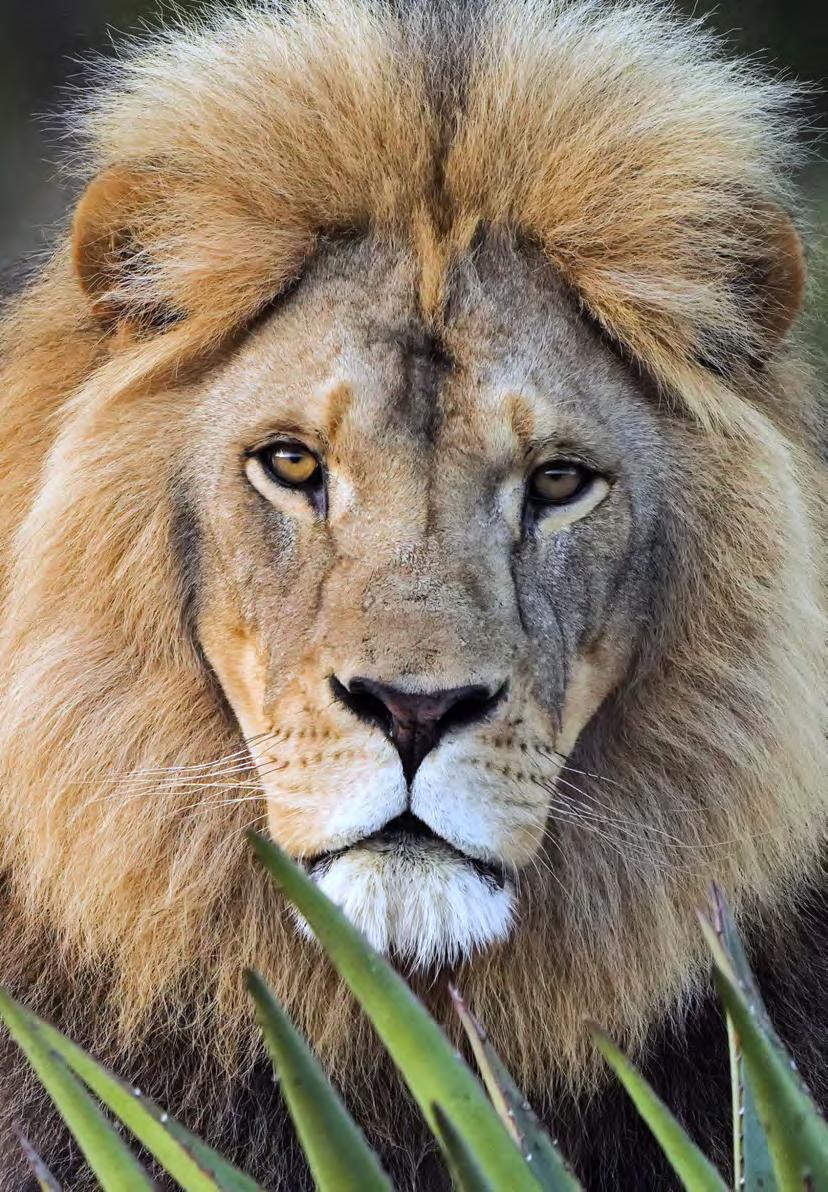
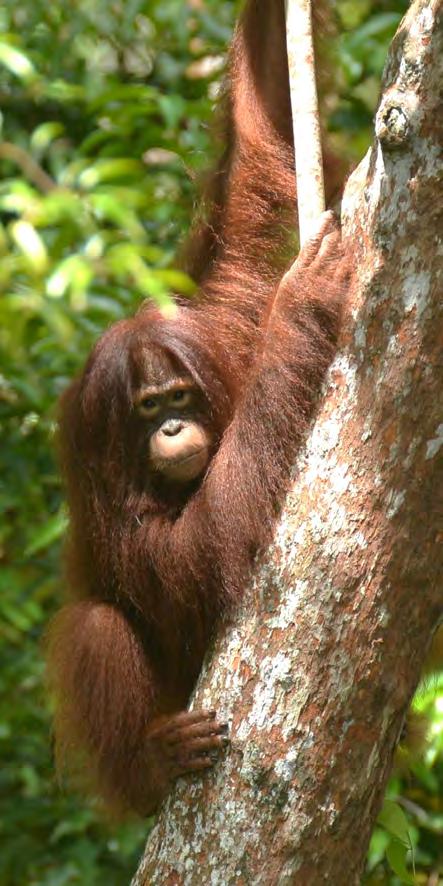
GO GREEN AND GO DIGITAL!
Perfect for any device, our online mag is no print, no post, low carbon and max support for your adopted animal! To take your My Adopt magazine everywhere you go, email info@bornfree.org.uk or call 01403 240170.





GO GREEN AND GO DIGITAL!
Perfect for any device, our online mag is no print, no post, low carbon and max support for your adopted animal! To take your My Adopt magazine everywhere you go, email info@bornfree.org.uk or call 01403 240170.

Welcome to the new edition of My Adopt magazine, produced exclusively for Born Free animal adopters. Whether you help look after an individual animal in a sanctuary, or protect a species in the wild, you’ll find their latest news and a dazzling new photo inside.
As an animal adopter, you’re a key part of a network of supporters all around the world. People like you, who care about wild animals and share our charity’s vision of a kinder world, and a more compassionate future.
Writing this welcome, I feel full of hope and optimism. It’s gives me enormous encouragement to know that you care about the wild, like me! So, sit back and enjoy this heartwarming read about what we’re doing for wild animals in need – together.

Will Travers OBE Executive President


@bornfreefoundation @
Like you, we’re wild about animals. We’ve been a voice for wildlife for over 40 years. You play a vital role in wild animal care and conservation. But, why not get even more involved? Visit bornfree.org.uk and join us on social media:
PS If you know someone who loves animals as much as you do, an animal adoption could be the perfect gift! Find out more at bornfree.org.uk/adopt
bornfreefoundation bornfreefdn
bornfreefoundation
bornfreefoundation
bornfreefoundation
None of our rescued animals in permanent care are allowed to breed; we vasectomise males or spay/give hormone implants to females. We do not want to add to captive populations, plus sanctuary space is in short supply, so we keep these precious spaces for animals most needing rescue.

BANNERGHATTA TIGER
SANCTUARY
INDIA
Home today: Lifetime care in a spacious forest enclosure
Background: Born in the wild but captured when he came into conflict with people by preying on cattle and goats
Arrived at sanctuary: 2014
Age today: 17
The very first animal Born Free ever rescued was a tiger – six in fact! In 1987, we took them from a squalid ‘beast wagon’ at a circus in Kent, UK and flew them to their spiritual home of India. Here they enjoyed a huge, lush forest sanctuary in Bangalore.

We describe magnificent Gopal as our ‘elusive guardian of the green!’ As the rains arrive in Bannerghatta, the sanctuary softens into a world of green and grey. Mist curls around trees, the scent of wet earth is thick in the air. Gopal, our wise and regal 17-year-old tiger, greets the monsoon with quiet dignity.
While his lush enclosure comes alive with birdsong and rustling leaves, Gopal prefers to stay dry, lounging beneath bamboo thickets or on his sheltered wooden platform, surveying his realm with unhurried eyes.
A creature of routine, rhythm and camouflage, Gopal is often heard before he’s seen, a low growl, or a rustle in the undergrowth as he moves with measured grace. His caregivers have introduced new hanging enrichments to challenge his strength and instincts, which he tackles with swats and stretches that remind us all of the magnificent predator within.
On warmer days, his pool offers both hydration and a cool reprieve, a private oasis for a tiger who values his solitude.
Thanks to your continued and unwavering support, Gopal continues to live a life that honours his wild spirit – peaceful, protected, and deeply respected.
Sandhi Priya Deputy Director, Corporate & Philanthropic Partnerships, Wildlife SOS

MERU NATIONAL PARK KENYA

Home: Kenya is a vital home for rare, reticulated giraffes and Born Free is in action to save them
Family: Around 1,400 live in the Meru-Greater Kora Ecosystem
Background: Just 16,000 wild reticulated giraffe remain, so the Meru population is significant and important

Enjoy fascinating footage of the giraffes at bit.ly/giraffe-action

Our incredible giraffe work has been on TV! A special Born Free event, including art projects for schools and the chance to spot giraffes in the wild, was reported on NTV Kenya, the nation’s No1 urban TV station: bornfree.org.uk/news/ celebrating-giraffes-in-kenya/

With your help, our team is protecting the majestic reticulated giraffes of Meru National Park. Meru is a stunning haven of almost untouched habitat, where these magnificent creatures can thrive among twigs and thorns.
Yet, despite its beauty, the park faces serious threats including climate change, poaching, and habitat loss. Born Free is rising to the challenge, advocating for the giraffes’ future and ensuring a stable population. The support from our local community is vital, leading to significant positive changes.
Since 2021, the Twiga* Team – employing local people – has conducted over 500 foot patrols, covering over 1,200 miles (2,000km) and removing 1,635 snares. Set illegally to trap ‘bushmeat’, these deadly snares pose a terrible risk to giraffes. Plus to date, we have identified 535 individual giraffes, enhancing our understanding of their movements and behaviours. Which improves conservation!
To combat climate change, our community engagement programme is busy planting trees, having established nurseries in schools, and restoring water catchment areas. We have reached over 10,000 local community members through educational forums, addressing conservation issues and fostering coexistence with giraffes.
This is only the beginning of our larger movement to ensure giraffes flourish for generations to come. With your support, we can create a brighter future for these giants of Meru. Thank you for joining us in this vital mission!
Newton Simiyu Programme Manager, Saving Meru’s Giants,
Born Free
*Twiga means giraffe in Swahili

Home today: Lifetime care in a spacious beech forest enclosure
Background: Rescued from Kastoria in northern Greece as a four-month-old, wild-born cub, with his twin brother Manolis, when their mother was killed
Arrived at sanctuary: 2004
Age today: 21
Kyriakos when rescued

Enjoy a heartwarming film of Kyriakos at bit.ly/kyriakos-enjoy

After a relatively short nap over last winter, Kyriakos was back in full force throughout the summer. Interestingly, while some of the rescued bears chose to build cosy natural dens for hibernation, Kyriakos – ever practical, opted for a ready-made shelter, saving thus his energy for more important things, like food and fun!
As the largest bear at the Arcturos Sanctuary, he is truly a breathtaking presence. With his massive frame and commanding aura, Kyriakos doesn’t go unnoticed. He starts each morning with spectacular dives into his refurbished pool, which he enjoys to the fullest. He’s known for his enthusiasm and daily splashing sessions.
His appetite? Still enormous. He devours everything in sight: fruit, fish, eggs, dog kibble, greens, even grass –basically anything edible. And just like a jubilant Sisyphus*, he likes to roll and tumble big rocks in pure joy… as if they were little pebbles!
Kyriakos is not just impressive in size he’s full of character, habits, and charm. At Arcturos, with your help we’re proud to offer him a safe space to live, thrive, and do what he does best: be the king of the mountain.
Panos Stefanou Director of Communications Arcturos
*In Greek mythology, Sisyphus was condemned to repeatedly roll an immense boulder up a mountain, only for it to roll back down.

Home: Living wild in Meru, 220 miles northeast of Nairobi
Family: Several adult females, plus sub-adults and cubs, led by males King and General
Background: One of Meru’s oldest lion families, named after the lioness star of Born Free, returned to the wild by George and Joy Adamson in 1958

Our Co-Founders Bill Travers MBE and Dame Virginia McKenna star in the film Born Free (1966)
Our charity logo features Elsa the lioness. She was a real lion who was returned to the wild in Kenya. The true story of her journey to freedom, retold in the classic film Born Free, inspires all we do. We never forget the importance of the individual.

With your support, we’ve had a season of hope. Elsa’s Pride continues to thrive in the golden heart of Meru National Park, with encouraging signs of growth and resilience. Late last year, the pride welcomed five new cubs, a significant addition that reflects the pride’s overall health and stability.
One of these new mothers is ResQ, Elsa’s* daughter. In 2021, at only eight months old, ResQ was spotted with a life-threatening wire snare around her neck. The snare was removed by the Kenya Wildlife Service vet team, supported by Born Free, and ResQ made a full recovery. Her two healthy cubs mark a powerful milestone in her journey from injury and recovery to motherhood.
These recent births bring renewed energy to the pride and serve as a testament to the effectiveness of ongoing lion conservation. The presence of playful cubs signals a hopeful future for this pride and our continued lion monitoring will ensure that they are given the best chance to flourish in the wild.
As always, thanks to your support, the Pride of Meru team remains committed and steadfast to monitoring Elsa’s Pride and protecting the remarkable lives of each of its members. Elsa’s Pride is more than a group of lions. It is a living legacy of your continued support. Thank you for all you do.
Michael Mugo & Moses Nyagah Programme Manager & Field Supervisor Pride of Meru, Born Free
*This Elsa was named in honour of the first Elsa the lioness

HANSON ISLAND
JOHNSTONE STRAIT
CANADA

Home: Living wild as part of British Columbia’s Northern Resident population monitored by OrcaLab, which has studied orca since 1970 and has been supported by Born Free since 1994
Family: 25-year-old Springer gave birth to Spirit in 2013, Storm in 2017 and a new calf in 2025
Background: In 2002, Springer’s mother Sutlej died and she became lost near Seattle, USA. Identified by her unique calls, with our help she was taken 250 miles by boat back to her wild family, the A4 pod, in the waters near OrcaLab

Orcas live in a ‘matriarchal society’ – the pod is led by an experienced older female, called a ‘matriarch’. She guides the group, teaching them the family’s unique calls or ‘vocal dialects’, and knows the best places to travel and where to find food.


We are absolutely thrilled to share some heartwarming news. Springer has been sighted with her third calf! This joyful update was accompanied by some stunning photographs of the family of four, as you can see. These were taken by our long-term colleagues – the research team at Whale Point, who study orcas and whales along the rugged beauty of British Columbia’s north coast.
Now 23 years since she was returned to her home waters, Springer’s journey has become nothing short of legendary. We’ve had the immense privilege of watching her reintegrate into her family pod, forge lifelong bonds with her extended family, and master the skills needed to navigate, communicate, and hunt across a vast and dynamic marine environment. Most remarkably, Springer has become a devoted and successful mother –and now, a matriarch – guiding her growing family with quiet strength and wisdom.
Her newest calf will soon be given a name, joining big siblings Spirit and Storm as they travel the coastal waters under their mother’s watchful eye. Springer’s story remains one of the most extraordinary and hopeful in marine conservation. As we celebrate the arrival of her third calf, we are reminded of the power of community, science, and compassion. Her success is a living testament to what’s possible when people come together for the good of a single life – and, in turn, an entire species. Springer’s legacy swims beside her now, and we look forward to many more updates as her story continues.
Helena Symonds and Dr Paul Spong Co-Directors, OrcaLab

Orangutans spend most of their lives in trees and, like gorillas and chimps, build comfy nests to sleep in. Orangutans are super-skilled, and infants usually learn by copying mum. They twist branches into a strong round base, then add a cushion of leaves and moss.
Home today: Gradually preparing for life in the wild at Camp Buluh
Background: Taken from her wild mother as a baby and kept illegally as a pet
Rescued: January 2016, aged nine months
Age today: Ten years


Enjoy some film of Timtom splashing in the water and playing with Sinta at: bit.ly/ timtom-play
Hold the front page! Huge news from Borneo. Timtom has finally built her very first nest!
As you might know, nest-building is a critical skill for orangutans. In the wild, individuals often build a new one to sleep in every single night. This is the last skill Timtom needed to develop, before she could be released and, up until this point, she’s never attempted it.
As you can imagine, Timtom’s carers were therefore delighted when, one afternoon, they looked up to see Timtom construct a ‘large and perfect’ nest in just 20 minutes! She then slept in it the whole night – a milestone moment for her.
Timtom has since been spending more nights in the forest to encourage her to practice this final skill. Though she is yet to make another nest, she has been repairing her old one with new branches and leaves. Evidently, she is capable of the skill and understands good nest quality – we hope she soon works on the quantity!
When not in the trees, Timtom still enjoys splashing in the water as she has always loved to do. Or encouraging her camp mate Sinta to abandon her own learning for some playtime in the trees. We are confident that with time, Timtom will make more nests, so that she can at last be ready for her independent chapter.
Zoe Bizicki Communications & Operations Officer Orangutan Foundation
BORN FREE’S SANCTUARY SHAMWARI PRIVATE GAME RESERVE SOUTH AFRICA
Home today: Lifetime care in a spacious enclosure with companion Thea
Background: Rescued from illegal pet trade in France, 2017
Arrived at Shamwari: July 2018
Age today: Eight years


Enjoy some wonderful footage of King and Thea at: bit.ly/king-sunshine
Not all wild lions are from Africa! Nearly 900 rare Asiatic lions are found in the Gir Forest in India. They’re very similar to their African cousins, but male Asiatic lions have darker, shorter manes, and both male and female Asiatic lions are smaller.

As winter settles over South Africa, it brings colder temperatures – even here in the Eastern Cape. King makes the most of the sunshine during the day, often seen basking in sunlit patches. When night falls and the chill sets in, he seeks out the comfort and warmth of his night house, a sheltered space to rest securely.
King continues to thrive –physically and mentally. He remains active and engaged –displaying natural behaviours such as rubbing against tree branches and sharpening his claws on logs. His powerful legs and strong muscles are put to good use as he effortlessly scales his climbing frame, keeping fit and agile.
Although very much an adult now, King still enjoys a good game of chase. Grooming also plays a vital role, keeping fur clean and free from parasites, but also strengthening bonds. King and Thea spend a great deal of time grooming one another, especially around the head, neck and back –using their rough tongues in this important social ritual.
King is in excellent health and eats well. His condition is a testament to the dedicated care he receives – and to you, his generous adopter. Thank you for being part of his journey.
Martin Miritiawo Animal Care Supervisor, Born Free

There are three species of elephants – one in Asia, and two in Africa –the savannah and the forest. At over 3m tall and 6,000kg in weight, the African savannah elephant is the world’s largest land animal. Their babies can weigh 90kg at birth!
AMBOSELI NATIONAL PARK KENYA
Home: Wild in Amboseli, a 150 square mile park at the foot of Mount Kilimanjaro
The EB Family: Dozens of members including sub-group led by Edwina (born in 1982), granddaughter to Echo, the matriarch star of BBC’s Echo of the Elephants who died in 2009
Background: Amboseli is renowned for its 1,800-strong elephant population, studied by Amboseli Trust for Elephants since 1972, supported by Born Free since 1992

With her distinct crossed tusks, Echo was the most famous elephant in the world

It has been a busy and eventful few months. The rains have left the landscape bountiful, and these conditions bring about some impressive elephant gatherings. When elephants come together in their hundreds, it’s an exciting — and at times exhausting — task for our research team! They move quickly to identify which families and males are present, while also taking note of who is missing and who has given birth to new calves.
The EB family remained largely outside the park during the rains, but we were able to track different subgroups, with some wonderful discoveries! A few months ago, Europa, daughter of Edwina, gave birth to a healthy female calf — her fourth. Then Enid, Edwina’s mother, gave birth to a male calf, as did her daughter Elise. The two are already very bonded and boisterous with one another.
Edwina’s daughter Elaine, also gave birth, this time to a female. It’s a joy to see so many new calves, their arrival brings excitement and energy to the family. As long as ecological conditions remain favourable, the chances of their survival are encouraging. Thank you for supporting our work – your contribution helps protect these elephants across generations.
Amboseli Trust for Elephants
Tal Manor Communications & Outreach Manager Amboseli
Trust for Elephants

Leopards are highly adaptable and the most widely distributed big cat, found in 63 countries. From deserts to rainforests, leopards are found in South Africa, up through Africa, across the Middle East and southeast Asia, and even in Far East Russia.
BORN FREE’S SANCTUARY SHAMWARI
PRIVATE GAME
RESERVE SOUTH AFRICA
THEIR STORY
Home today: Lifetime care in their own spacious bush enclosures
Background: Rescued from a failed zoo in South Africa in 2020
Age today: Mowgli six and Zeiss eleven

You’ll love our heart-warming new film of Mowgli and Zeiss, enjoying life at Shamwari, at: bit.ly/ leopards-explore

With your help, Zeiss continues to thrive, and is often seen lounging peacefully in his favourite shaded spots. Other times, when it’s quieter, we see him strolling near his viewing deck or exploring his enclosure.
We’re incredibly pleased with Zeiss’s progress, and his growing confidence. He is visibly more relaxed – a testament to the gentle, patient care he receives. Zeiss has a hearty appetite and truly enjoys his meals. We carefully monitor his diet – important for his long-term health and wellbeing.
Mowgli remains the most private and elusive cat in our care.
We monitor his condition and behaviour thanks to cameras positioned discreetly around his spacious enclosure. Because of his traumatic history at the zoo, we ensure his space remains a sanctuary of calm. But it’s good to occasionally see him frolicking and chasing the odd butterfly!
He’s also in excellent health, with a healthy appetite and maintaining a strong and striking physique. He is, without question, the most breathtaking leopard I’ve ever seen! Thank you for making it possible for Zeiss and Mowgli to live peaceful, enriched lives. Your generosity means the world – to us and to them.
Glen Vena Animal Care Manager,
Born Free

LILONGWE
WILDLIFE
TRUST
LILONGWE
WILDLIFE
CENTRE
MALAWI

We have fantastic news to report. With the invaluable support of your adoption, Puck the orphaned pangolin, rescued in September 2023, has been successfully returned to the wild in a secret and protected area.
Home today: Malawi’s only wildlife sanctuary gives expert one-on-one treatment to rescued Temminck’s pangolins, returning to the wild if possible. Lilongwe Wildlife Trust also fights wildlife crime and supports conservation
Background: Injured and orphaned pangolins, especially victims of illegal wildlife trade, are rescued, rehabilitated, then released and monitored in safe places
Action: In 2007, Born Free helped Lilongwe Wildlife Centre to develop from a former zoo. Today their pangolin work includes two regional hubs which act as ‘first response units’
He was just days old and weighed 340g, when taken in. But after regular bottle-feeds, then graduating to ants and termites, he weighed an awesome 7.08kg – over 20x bigger! Since being released, he has been under the careful watch of our research team and is clearly thriving. In his latest check-up he tipped the scales at a solid 8kg.
Puck has not ventured far from his release site, but seems to be gradually exploring northward within the park. The best part? Puck is not keen on human interaction, flapping his tail vigorously during post-release weighins, as if to say, ‘I’m a free pangolin now!’ What a fantastic sign that he is adapting well to his new life in the wild.
Kondwani Kusakala Head of Wildlife Rehabilitation Lilongwe
Wildlife Trust
With your help, Born Free’s pangolin appeal earlier this year, was a huge success. It raised £55,000 to rescue pangolins, stop criminal gangs, give pangolins better protection against wildlife traffickers, and support their conservation in the wild.
You can see some fantastic film of Puck going wild at: bit.ly/puck-wild
Unlike most wild cats, cheetahs are ‘diurnal’ and prefer to hunt during the day. Unlike the other big cats, cheetahs aren’t good climbers and rarely climb trees. They also can’t roar, but instead can purr, chirp and make high-pitched calls!

Enjoy some new footage of the Cheetah Family at: bit.ly/blue-xray
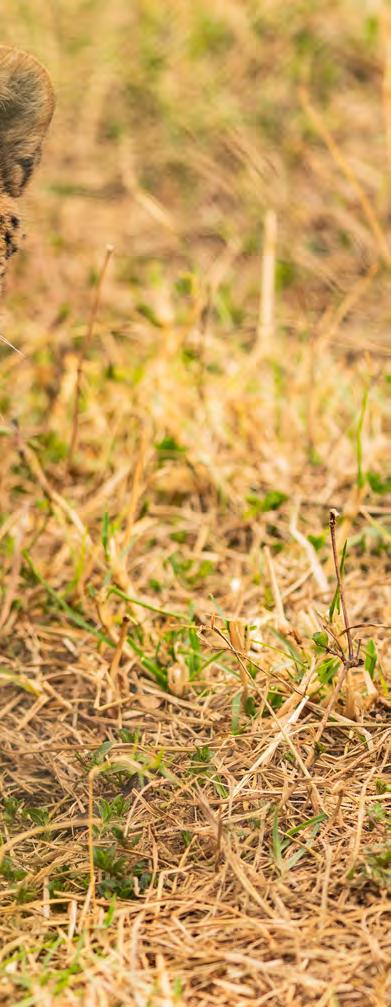
Home today: Spacious natural enclosures with undergrowth to explore and room to run
Background: Mostly victims of the illegal pet trade, stolen from the wild as cubs
Arrived at Ensessa Kotteh: 2011 to 2024
Age today: From under one, to 14 years
Your Cheetahs:
Girls Rescued
Blue Aug 24
Fasika Apr 23
Sisay (aka Jijiga) Dec 21
Konjo (aka Tamu) Apr 15
Choa (aka Nura) Apr 15
Boys Rescued
Ramadan Apr 23
Dima June 22
Dehar Jan 22
Timkat Jan 11

As the rainy season sweeps across Ensessa Kotteh, the landscape has transformed into a lush, green haven — and the Cheetah Family is making the most of it! Their spacious enclosures are now carpeted in thick grass, perfect for a good stretch and a lazy lounge when the sun makes an appearance. The cooler weather and abundant scents on the breeze have given them a new burst of energy, and their playful streak has been on full display.
Blue, our youngest and most delicate resident, continues to amaze us with her quiet resilience. She’s moved into a larger enclosure – and clearly enjoys the extra space to explore. Her movements remain tentative, and our expert team continues to monitor her closely, but she’s building strength. Injured in a car accident, Blue still has a long way to go to fully recover, but her appetite is good, her confidence growing, and she loves sniffing out new scents, introduced as part of her enrichment routine.
Meanwhile sisters Konjo and Choa remain inseparable. They gracefully move through their habitat, ever alert to the goings-on around them. Whether lazing side by side, grooming one another, or perking up at the sight of a bird flitting by, their gentle companionship is a joy to witness. Our team works tirelessly to ensure each cheetah receives the individual care they need to thrive. Thank you for standing with us on their journeys – from fragile beginnings to stronger futures.
Bereket Girma Head of Centre & Country Director, Ethiopia, Born Free

YOU KNOW?
Your adoption also helps protect gorillas living wild in the rainforests of Cameroon. To promote conservation, we employ local Great Ape Guardians, support anti-poaching patrols, help people develop eco-friendly trades, and plant trees to restore the forest.
Home today: Cared for in a spacious rainforest enclosure, at Ape Action Africa’s sanctuary
Family: A large rescued group of Critically Endangered western lowland gorillas, led by the mighty silverback Bobo
Background: Since July 2024, Born Free has supported the care of our new family of adopted gorillas, at this renowned sanctuary

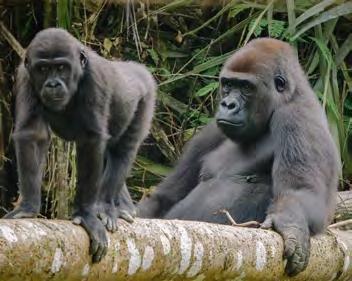

Exciting news. We’re preparing to introduce two rescued monkeys into Bobo’s group. Based on our previous success introducing monkeys and gorillas, we’re optimistic these male guenons*, Kit and Buddy, will find their forever home in Bobo’s forested enclosure.
We’ve made several important modifications. The gorilla night houses have been adapted to accommodate our new residents, and we’ve adjusted the fencing too. We’ll give Kit and Buddy plenty of time to adjust, and the initial introduction will be through visual contact only. This allows both the monkeys and gorillas to become familiar with each other and helps reduce stress.
We’re delighted that orphaned baby gorilla Barbie, who very sadly was shot by poachers, has made amazing progress since being introduced to her surrogate mother Luci six months ago. Adult female Luci, herself orphaned as an infant, is thriving in her new role as mother and teaching Barbie essential social behaviours.
Another female in the group, Chickaboo, also ensures that Barbie is well taken care of. When larger gorillas become a little too enthusiastic during play, Chickaboo steps in to make sure young Barbie remains safe and happy.
Ian Bickerstaff Trustee
Ape
Action
Africa
*A group of medium-sized, long-tailed monkeys
MERU NATIONAL PARK KENYA
Home: Rhino Sanctuary within Meru National Park
Family: An important population of 91 white and 32 black rhinos, protected by rangers with our help
Background: After a poaching epidemic in the 1980s, Born Free has been helping Kenya Wildlife Service (KWS) since 2014 to restore Meru’s wildlife, including rhino, to its former abundance

Rhinos are a ‘keystone species’, and play a vital role. They create waterholes by wallowing in mud puddles and keep vegetation trimmed back by eating vast quantities of plants. They then fertilise the ground and disperse seeds through their dung.

Did you know that rhinos have been around for 50 million years?! Once over 100 species roamed across the world –not least the incredible woolly rhino, and included some of the largest land animals that have ever lived. Now, five species of rhino remain, including the white and black rhinos found in Meru.
Kenya has been dedicated to rhino conservation and across the country, rhino numbers are increasing. With your help, the Rhino Sanctuary in Meru continues to provide a safe haven for both black and white rhinos, protected day and night by KWS Rangers.
Interestingly, given their large size but relatively short legs, rhinos can’t step over obstacles easily. This means that while they remain in a vast fenced sanctuary in Meru – some 35 square miles in size –other wildlife can come and go easily. Using small wooden stubs, the fence keeps the rhinos safe under the watchful eye of
KWS rangers, while allowing other wildlife to move in and out of the sanctuary (see pic left).
Thanks to government dedication and your support, magnificent individuals like Gakuya the dominant male, and Tana the supermum, can safely roam freely within the sanctuary.
Tana is named after the Tana River, Kenya’s longest and most vital waterway, which marks the southern boundary of Meru National Park. Just as the river sustains life across the country, Tana the rhino is playing a crucial role in conservation. A thriving symbol of hope, she has raised seven calves in Meru, helping to secure the future of her species.

Anna Cryer Conservation Admin & Comms Officer Born Free





bornfree.org.uk/news
Take on a challenge and raise funds for your favourite animal. You can walk, run, cycle, swim or climb!
Our Events Calendar has something for everyone, from family-friendly walks to epic treks and global adventures.
Find out more and sign up at: bornfree.org.uk/fundraising/ challenges

London Halloween Walk
Sat 25 October 2025 Central London 10km or 25km

Why not risk a hair-raising hike around some of the City’s scary streets and historic haunts? Will Drew took on the Isle of Wight 100km, and came 10th! The Storey family climbed Mount Kenya to raise funds for Born Free!



